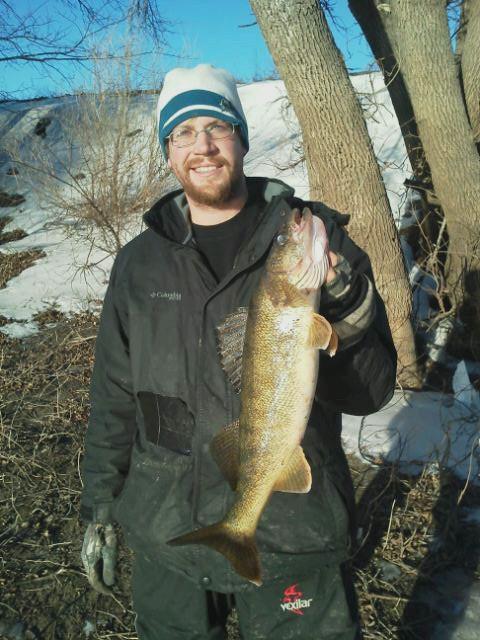
With the first open water of the season comes a chance at walleyes on the long rod. Find where they are and adjust to the take to set the hook on the first fish of spring, even if some snow remains on the ground. Simonson Photo
By Nick Simonson
In the cold of early spring, it’s not uncommon to see anglers patrolling those early openwater areas for the first active walleyes of the season.
As they stage for their spawning run, these fish provide a welcome bite for those looking to break out the long rod and shake the rust off with a few casts from a winter spent huddled over an ice hole. However, early spring walleyes can provide a unique challenge for anglers and tactics vary greatly in the chilly water from those which will come just ahead of the spawn or later in the openwater season when rivers run a bit warmer and fish are more aggressive. What follows are ideas to explore and hints to serve as a base in feeling out spring walleyes.
Spring walleyes can often be found in the first openwater of the season relating tight to the bottom. Utilizing current breaks such as slight shifts in depth, sand bars or obstructions such as rocks and boulders, the low-light opportunists will hold out of the fast current, waiting for easy meals. Putting an offering to match their mood in the right place will help entice a bite and utilizing a jig that makes contact with the bottom in those slackwater areas, eddies, and seams is the first step in finding out where the fish are. Using a no-stretch superline will help feel out the bottom and detect those bumpers like boulders and bottom shifts that determine where spring walleyes are resting and waiting for food. Additionally, the sensitive line will also telegraph subtle bites that spring walleyes are known for, serving a dual purpose this time of year.
Another thing to consider is the tentative nature of spring walleyes.
While sometimes they may inhale an offered bait bumped along in front of them on the river bottom, more often than not, they’ll slowly eat an offering and it may take a count of as long as five or ten before the hook point is anywhere near a fish’s mouth. If a minnow is coming back with a few scales missing along the back side of its body, odds are that walleyes are slowly taking the offered bait, and more time is required from the detection of a first bite to a hookset. Count down and wait to feel a slight bend in the rod before setting the hook on the next subtle tap. While the situation can be maddening at times, testing the patience of the most seasoned angler, waiting can pay off with more fish when they’re being stubborn about the speed at which they take an offering. The addition of a stinger hook can help with the problem, however, it may also affect the natural movement of the baitfish offered up, and can also increase fouling of a presentation with debris such as last autumn’s leaves still found on the bottom of a flow. Play the adding on of a stinger hook by water conditions and the mood of the fish.
The timing of the spring run often brings the smaller male walleyes to the forefront of a staging area, providing anglers with a good opportunity for some eaters, but that’s not to say there aren’t some opportunities to hook into some bigger female fish too. Be selective ahead of the spawn and release those bigger fish to deposit their eggs and beget the next generation to help sustain fisheries that are self-sustaining. Utilizing jigs, allows for greater sensitivity and better hook placement, preventing damage to spring fish and an easier release. Use a rubberized net to further prevent damage to those fish which will be released.
This spring, take advantage of those first opportunities to open up on flowing water where walleyes can be found. Feel out the bottom and find those classic haunts where fish hold against the flow and pick off easy meals, noting that the take may move in slow motion this time of year.
Wait for a solid connection and set the hook. While spring may provide a few different aspects and sometimes excruciatingly delicate rod work, the adventures can be worth it, especially after a winter away from the action.
